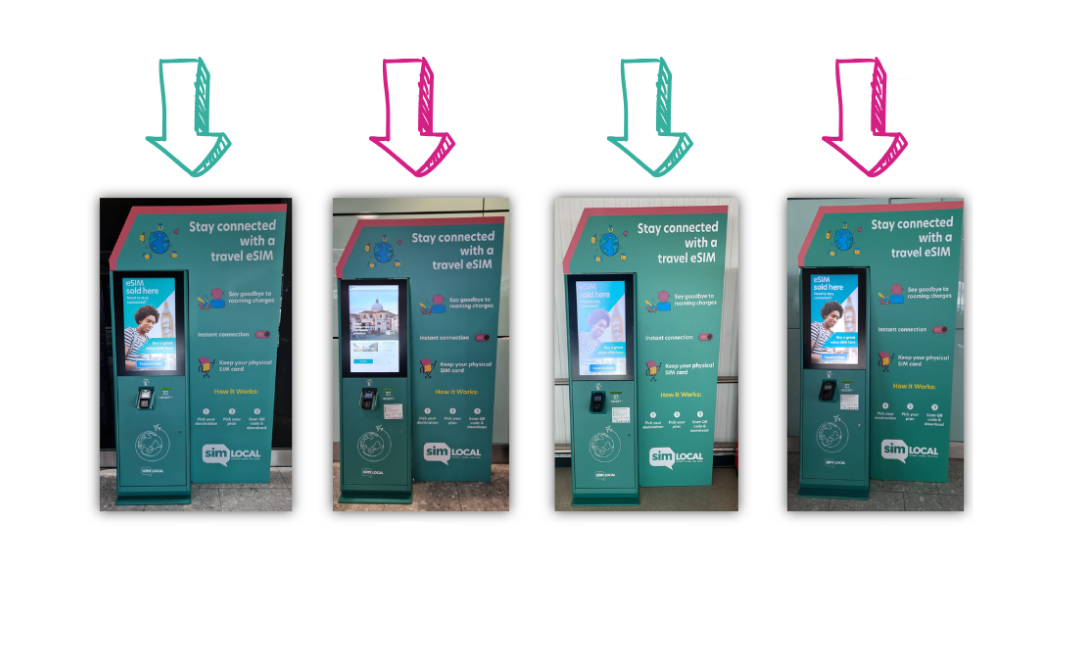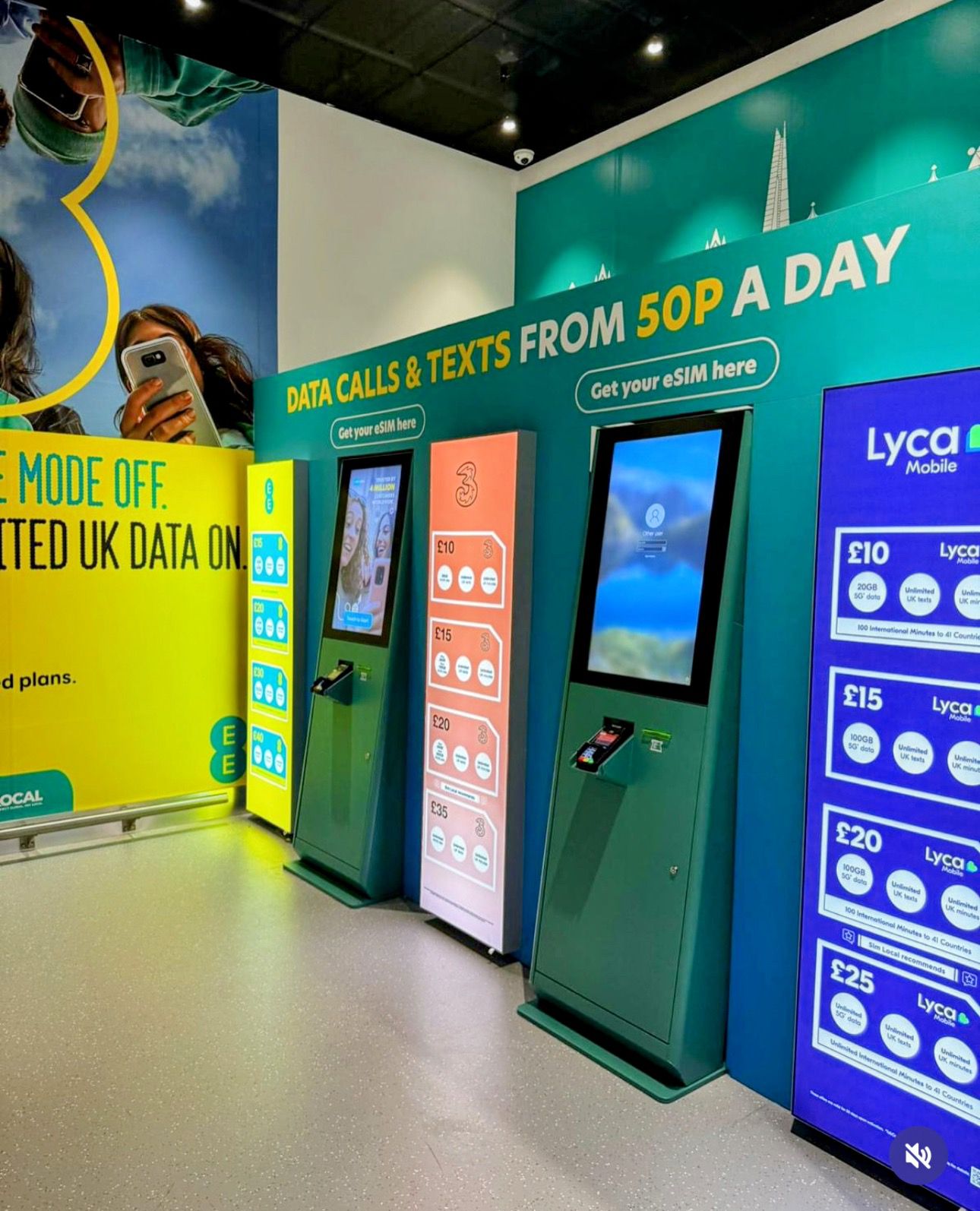 Sim Local Launches New eSIM Kiosks in Heathrow Departures
Sim Local Launches New eSIM Kiosks in Heathrow DeparturesSim Local have launched four eSIM kiosks at Heathrow, offering even more ways to get connected. Learn more here.
Read More
By Georgia Brivida
Head of Product Delivery, SimLocal
The telecom retail landscape is undergoing a profound transformation. Gone are the days when customers patiently waited in a carrier’s store to purchase a SIM card or upgrade a phone plan. In a world of instant digital services, telecom and tech executives are recognizing that the traditional shop model must evolve. One emerging solution is the self-service kiosk – a small, automated retail point that can handle everything from SIM/eSIM activation to bill payments. This thought leadership piece explores why kiosks are poised to become the future of telco retail, focusing on global trends with a spotlight on the UK and Europe. Backed by data and real examples, we outline three key drivers:
Today’s consumers expect convenience, speed, and autonomy in their shopping experiences. Retail surveys show that over 80% of consumers want self-service options in stores. In telecom retail, this translates to customers preferring quick, DIY methods for routine transactions – whether it’s activating a new SIM or checking out with accessories – rather than waiting in line for a sales representative. Younger, tech-savvy demographics are especially drawn to digital self-service; for example, 72% of Gen Z shoppers value self-checkout technology (versus 55% of consumers overall). This generational shift underscores a growing expectation for frictionless, tech-enabled retail experiences.
Traditional telco stores have struggled to keep up with these expectations. Long wait times and paperwork can frustrate customers who are used to the instant gratification of apps and online services. In fact, one case study from Orange (a major European operator) found that customers demanded immediacy – the ability to activate SIMs, order products, and manage transactions without relying on staff. Self-service kiosks directly address this need for speed and simplicity. By automating common tasks, kiosks let customers serve themselves 24/7. Here at Sim Local we operate digital kiosks in airports that let travellers get connected quickly, at any time. A customer arriving on a late flight can walk up to a kiosk, purchase a local plan, and be on their way in minutes – no store hours or queues to worry about.
Crucially, modern kiosk technology has matured to meet customer expectations. Early self-checkout machines in retail had a reputation for glitches, but new telecom kiosks are designed to be fast, intuitive and reliable. Industry experts note that shoppers really want two things from self-service: speed and simplicity. Kiosks in telco retail can deliver on both. They provide a consistent, guided interface for tasks like eSIM purchases or top-ups, minimising the chance of human error. And if implemented well, they reduce wait times In short, telco kiosks align perfectly with the demand for a frictionless customer journey, allowing people to get what they need instantly and independently. Of course, some customers will always value the human touch, so it's essential to provide as part of a seamless omnichannel experience.
Perhaps the most compelling catalyst for kiosk-based telco retail is the rise of the eSIM (embedded SIM) and the broader digital transformation of mobile services. eSIM technology eliminates the need for physical SIM cards, enabling users to activate a mobile plan via software. This trend is not abstract or distant – it’s happening now at an accelerating pace. In 2024, global eSIM shipments grew 35% year-on-year to over 500 million units, and consumer eSIM activations surged by 56%. Europe is seeing strong uptake alongside North America and Asia as more eSIM-only devices (like certain smartphones and wearables) enter the market. For telecom operators, embracing eSIM is a key part of digital transformation, allowing them to provision service remotely and streamline the customer onboarding process.
Kiosks play a unique role in driving eSIM adoption. They act as physical-digital bridges: a customer can walk up to a kiosk and, instead of receiving a plastic SIM, receive a QR code or digital download to instantly install an eSIM profile on their phone. This merges the convenience of online activation with the tangibility of a retail point of sale. Consider the recent example of Sim Local’s eSIM kiosks at London Heathrow Airport. In 2024, Sim Local launched a trial network of self-service kiosks in Heathrow’s terminals, aimed at tech-savvy travellers. They can be configured for inbound or outbound travel. Outbound customers simply select their destination and plan on the touchscreen, then receive a QR code to scan with their smartphone, yielding immediate connectivity once they land. It’s a prime illustration of how kiosks can educate customers about eSIM and get them online in a matter of minutes, with zero need to swap physical cards. For domestic user or inbound travellers self-service kiosk for eSIMs (such as those by Sim Local) lets users pick a mobile data plan and instantly download the eSIM via QR code, eliminating the need for a physical SIM card. This ease of use is helping to drive broader eSIM adoption in retail settings.
The move to kiosk-based eSIM distribution is gathering momentum globally. In the UK, eSIM provider GK Telecom announced plans to roll out 1,000 touchscreen eSIM kiosks nationwide, placing them in hotels, airports, and malls. These kiosks will allow travellers and locals alike to purchase eSIM plans that work in 160 countries, through a user experience as simple as ordering a meal at a fast-food kiosk. Such initiatives not only highlight the convenience factor, but also accelerate eSIM usage by making it highly accessible. Every kiosk becomes an opportunity to convert a customer to eSIM on the spot. From a telco’s perspective, this is transformative: it reduces reliance on physical SIM inventory and manual processes, moving the needle toward fully digital provisioning. The “digital-first” strategies pursued by operators (especially in markets like North America) go hand-in-hand with kiosk deployments. By investing in eSIM-enabled kiosks, telcos are effectively extending their digital transformation into the physical world – creating smart touchpoints where customers can engage with purely digital products (eSIMs) in a convenient offline setting.
Importantly, kiosks can also help overcome one of the barriers to eSIM adoption: customer awareness and education. Many consumers still aren’t familiar with eSIM or are unsure how to activate it. Kiosks provide a guided, user-friendly introduction. In Sim Local’s Heathrow trial, for example, on-site staff were present initially to assist and educate travellers on the benefits of eSIM and how to activate it. This hybrid approach – combining digital kiosk delivery with human support for questions – can accelerate the mainstream acceptance of eSIM. As eSIM becomes the norm (some smartphone makers have already removed physical SIM slots in certain regions), having a ubiquitous network of kiosks to serve customers will be a competitive advantage for operators. It ensures that even as connectivity goes digital, the retail experience remains accessible to all, including those who may not be comfortable doing everything through a website or app.
Beyond consumer preferences and new technology, there is a hard business logic to why telco kiosks are gaining traction: cost and operational efficiency. Running extensive networks of brick-and-mortar stores with full staff is expensive. Real estate, staffing, and utilities contribute to high overheads at a time when operators are under pressure to improve margins. Meanwhile, foot traffic in telecom stores has been declining – one study noted a 20% drop in traditional in-person store visits post-pandemic. The pandemic accelerated online shopping habits and introduced customers to alternatives like curbside pickup and online SIM activation. Telcos have had to re-evaluate their channel strategies, looking to reduce the cost of their retail footprint while still serving customers effectively.
Self-service kiosks offer a compelling solution to this challenge. According to industry analysis, telcos can deliver the digital experiences customers crave and dramatically cut costs by deploying self-service solutions. A kiosk can operate in a small space (or even as a wall-mounted unit), with no on-site staff, and serve customers around the clock. This means carriers can maintain a presence in locations that could never justify a full store – for example, a kiosk in a hotel lobby or a train station – extending their reach without the usual overhead. The UK is seeing exactly this trend: third-party providers and operators are placing kiosks in high-traffic venues and sharing revenue with hosts. In other words, the kiosk model turns retail into a flexible, scalable network. An operator could have hundreds of micro-outlets (kiosks) for the cost of a few flagship stores, reaching customers wherever they may need service.
Kiosks also fit perfectly into telcos’ omnichannel strategies. Forward-looking telecom retailers no longer view physical stores in isolation – they see them as part of a seamless continuum with online and mobile channels. A recent industry survey of telecom retail professionals across North America found broad agreement that physical stores remain important only as part of an omnichannel experience – carriers need to meet customers wherever they are. In practice, this means enabling customers to “buy anywhere, anytime”: in-store, online, via social media, or at alternative touchpoints like kiosks and pop-up stores. For telcos in the UK and Europe, kiosks can act as mini-stores or support pods that complement their online sales. A customer might begin a purchase on a website and then use a kiosk to pick up a SIM or finalize activation. Or vice versa – someone could discover an offer at a mall kiosk and later manage their account through the operator’s app. The consistency of experience across these channels is key to customer satisfaction.
Real-world deployments indicate that kiosks can significantly improve efficiency and reduce operating costs in telecom retail. The case of Orange Spain is illuminating. By installing self-service terminals in their stores (through a partnership with Tecalis), Orange transformed its retail operations. Routine processes that once tied up staff for extended periods were automated. For example, the time to activate a SIM card dropped from 13 minutes to just 2 minutes using the kiosks, and this freed up roughly 1,100 employee hours per month in a single store. These are staggering gains in productivity and cost-saving – staff can be reallocated to higher-value activities like customer consultations or store footprint can be optimized. Moreover, the kiosks enabled instant and secure eSIM activations and other services in a fully unattended mode, underscoring that even complex transactions can be handled without direct human involvement. The net effect is an omnichannel retail model that is both lean and customer-centric: customers get faster service, and the operator reduces its cost-to-serve.
It’s worth noting that kiosks aren’t about eliminating the human touch completely. Instead, they allow telcos to reimagine the role of physical retail. As experts have pointed out, tomorrow’s telecom retail may span various formats – from flagship experience centres to compact express stores and unmanned kiosks – each serving a purpose. Kiosks take on the heavy lifting of straightforward transactions and inquiries, while human staff can focus on complex sales, support, and relationship-building. This balance can boost overall customer experience and loyalty. In an era when telecom services are increasingly commoditized, providing a smooth and convenient buying journey can be a differentiator. And doing so cost-efficiently via kiosks ensures it’s sustainable for the business.
The convergence of consumer expectations, technological evolution, and operational necessity is making kiosk-based retail a strategic imperative for telcos. Customers in the UK, Europe, and around the world are signaling that they value quick, self-service experiences – and they will gravitate towards providers who offer them. The surging adoption of eSIM and digital channels, meanwhile, is paving the way for more automated, software-driven retail processes that kiosks are ideally suited to deliver. Finally, the economics cannot be ignored: kiosks promise a leaner, more agile retail presence that aligns with omnichannel trends and cost-saving goals in the telecom industry.
In this new paradigm, we can envision telecom kiosks in airports activating eSIMs for travellers in seconds, kiosks in shopping centres handling phone upgrades or bill payments, and kiosk pods in convenience stores extending a carrier’s reach into communities – all connected to the cloud and integrated with the operator’s digital platforms. Telco and tech executives should view these not as vending machines, but as strategic customer touchpoints. The case studies and data already show positive outcomes: higher customer satisfaction, faster service, and significant savings. As the sector continues to innovate, those carriers that invest in kiosk-based retail (alongside their online and traditional channels) will be well positioned to thrive in the omnichannel, eSIM-enabled future of telecom retail. The writing is on the wall – or rather, on the kiosk screen – that the future of telco retail is fast, frictionless, and conveniently located wherever the customer needs it. Kiosks are here to stay, and they are shaping the next chapter of telecom retail.
Sources:
Contact Sim Local to discuss your digital eSIM kiosk needs at partners@simlocal.com.
 Sim Local Launches New eSIM Kiosks in Heathrow Departures
Sim Local Launches New eSIM Kiosks in Heathrow DeparturesSim Local have launched four eSIM kiosks at Heathrow, offering even more ways to get connected. Learn more here.
Read More The World's Best Christmas Cities (2025 Edition)
The World's Best Christmas Cities (2025 Edition)For the 2025 holiday season, we analysed 6 top cities to visit at Christmas - ranking them on the metrics that actually matter: Weather, Activities, Food & Drink, Traditions, Pop Culture (movies!) & Shopping.
Read More 7 Cheapest Ski Resorts in Europe for 2026
7 Cheapest Ski Resorts in Europe for 2026Find the most affordable ski resorts in Europe for 2026! Explore budget-friendly destinations, top tips & deals to plan your perfect winter getaway.
Read MoreDestination
Shop
About
Help
Contacts:
© 2025 Sim Local (IRELAND) Ltd. All Rights Reserved.